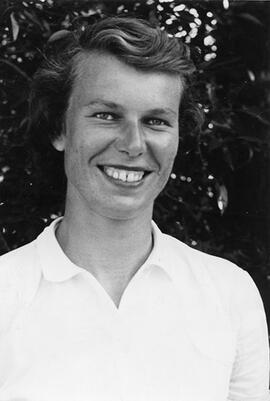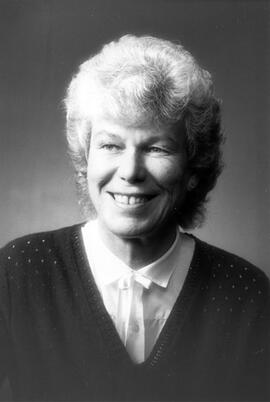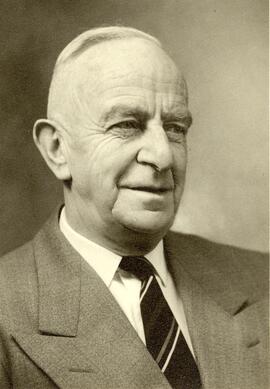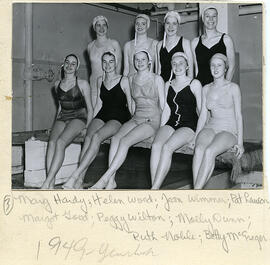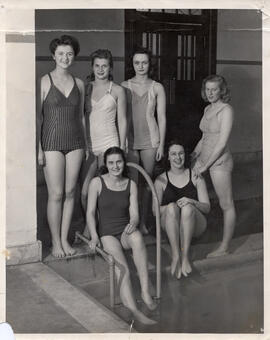Emmett M. Hall, University Chancellor, making presentation of an honourary Doctor of Laws degree to Dr. Jessie Caldwell at special 75th anniversary Convocation held at Centennial Auditorium. Iain MacLean, University Secretary, applauds at left.
Bio/Historical Note: Dr. Jessie Rowles Caldwell was born in Manchester, England in 1901. The family emigrated to Canada in 1910, eventually settling on a Saskatchewan homestead near the Alberta border town of Empress in 1915. After attending Normal School in Saskatoon she taught at Eston before enrolling in the University of Saskatchewan in 1920, earning her way by teaching in rural schools and working for the Dominion Chautauqua during the summers. In 1924 Dr. Caldwell received her BSc, graduating in the same class as her brother William Rowles, and preceding one other brother and two sisters, all of whom graduated from the U of S. Following her marriage in 1924 to Dr. Alexander L. Caldwell (1892-1959) and the establishment of his medical practice in Cabri, Saskatchewan, she began her public service in earnest as chairman of the Cabri Consolidated School Board from 1929-1941. Dr. Caldwell served the U of S from 1930-1951 as the first woman alumni representative elected to the University Senate, and was an active member of the University Women's Club for 40 years. When her husband joined the Royal Canadian Army Medical Corps in 1941, she and her son Thomas David Roberts (Bobs) Caldwell (1933-2019) moved to Saskatoon where she was appointed to the volunteer Dependents' Advisory Committee to the Armed Forces for the Saskatoon Region. Dr. Caldwell was the first woman appointed to the National Film Board of Canada. Her keen interest in international affairs and her work with the Canadian Institute of International Affairs, and the United Nations Association in Canada, Saskatoon Branch, was recognized by her appointment in 1953 as a member of the Canadian delegation to the Eighth General Assembly of the United Nations, the first Saskatchewan citizen to serve on the delegation. Dr. Caldwell later served as joint chairman of the Saskatchewan World Refugee Year Committee and travelled and spoke extensively on the work of the United Nations. Dr. Caldwell's years of service to the Council of Women were rewarded by life memberships of all three levels of the Council - local, provincial and national. As well as serving as president or on the executive at all levels, she wrote and edited the Saskatoon and National newsletters for many years, and wrote part of the history of the Saskatoon Council. Dr. Caldwell was a founding member of the Canadian Association of Consumers.
A member of Knox United Church, Dr. Caldwell held office at all levels, including serving on the National Board of Evangelism and Social Service and the National Commission on Immigration. For 6 years she was a member of the Board of Governors of St. Andrew's College. Dr. Caldwell stood for election twice: in 1952 for the provincial legislature and in 1958 for the Parliament of Canada. She served as president of the National Federation of Liberal Women of Canada and as first vice-president of the National Liberal Association of Canada, following similar service at the local and provincial levels. Dr. Caldwell was a founding member of the Saskatoon Art Centre Association. She was president and honourary president of the Saskatoon Archaeological Society and was an honourary life member of the Saskatchewan Archaeological Society. In addition to the host of honourary and life memberships, and listing in the Canadian Who's Who, She was honoured as Saskatoon's Citizen of the Year, and the Government of Saskatchewan, and was named a Canadian Achiever by the Government of Canada. Dr. Caldwell died in 1990 in Saskatoon at age 89. Bio/Historical Note: Dr. Jessie Rowles Caldwell was born in Manchester, England in 1901. The family emigrated to Canada in 1910, eventually settling on a Saskatchewan homestead near the Alberta border town of Empress in 1915. After attending Normal School in Saskatoon she taught at Eston before enrolling in the University of Saskatchewan in 1920, earning her way by teaching in rural schools and working for the Dominion Chautauqua during the summers. In 1924 Dr. Caldwell received her BSc, graduating in the same class as her brother William Rowles, and preceding one other brother and two sisters, all of whom graduated from the U of S. Following her marriage in 1924 to Dr. Alexander L. Caldwell (1892-1959) and the establishment of his medical practice in Cabri, Saskatchewan, she began her public service in earnest as chairman of the Cabri Consolidated School Board from 1929-1941. Dr. Caldwell served the University from 1930-1951 as the first woman alumni representative elected to the University Senate, and was an active member of the University Women's Club for 40 years. When her husband joined the Royal Canadian Army Medical Corps in 1941, she and her son Thomas David Roberts (Bobs) Caldwell (1933-2019) moved to Saskatoon where she was appointed to the volunteer Dependents' Advisory Committee to the Armed Forces for the Saskatoon Region. Dr. Caldwell was the first woman appointed to the National Film Board of Canada. Her keen interest in international affairs and her work with the Canadian Institute of International Affairs, and the United Nations Association in Canada, Saskatoon Branch, was recognized by her appointment in 1953 as a member of the Canadian delegation to the Eighth General Assembly of the United Nations, the first Saskatchewan citizen to serve on the delegation. Dr. Caldwell later served as joint chairman of the Saskatchewan World Refugee Year Committee and travelled and spoke extensively on the work of the United Nations. Dr. Caldwell's years of service to the Council of Women were rewarded by life memberships of all three levels of the Council - local, provincial and national. As well as serving as president or on the executive at all levels, she wrote and edited the Saskatoon and National newsletters for many years, and wrote part of the history of the Saskatoon Council. Dr. Caldwell was a founding member of the Canadian Association of Consumers.
A member of Knox United Church, Dr. Caldwell held office at all levels, including serving on the National Board of Evangelism and Social Service and the National Commission on Immigration. For 6 years she was a member of the Board of Governors of St. Andrew's College. Dr. Caldwell stood for election twice: in 1952 for the provincial legislature and in 1958 for the Parliament of Canada. She served as president of the National Federation of Liberal Women of Canada and as first vice-president of the National Liberal Association of Canada, following similar service at the local and provincial levels. Dr. Caldwell was a founding member of the Saskatoon Art Centre Association. She was president and honourary president of the Saskatoon Archaeological Society and was an honourary life member of the Saskatchewan Archaeological Society. In addition to the host of honourary and life memberships, and listing in the Canadian Who's Who, She was honoured as Saskatoon's Citizen of the Year, and the Government of Saskatchewan, and was named a Canadian Achiever by the Government of Canada. Dr. Caldwell died in 1990 in Saskatoon at age 89. The Rowles sisters - Jessie Caldwell, Edith C. Rowles Simpson and Winnie Rowles - are honoured with the designation of 'Rowles Road' in the Silverwood neighborhood of Saskatoon.

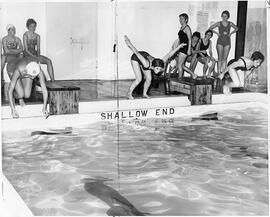
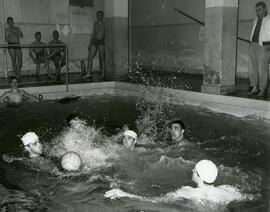
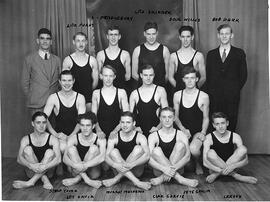
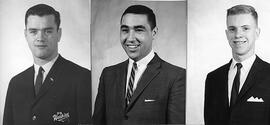
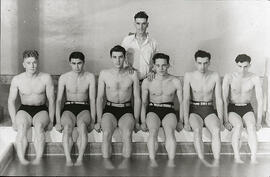
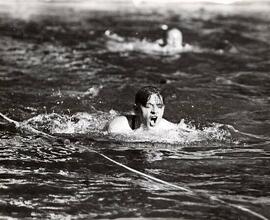
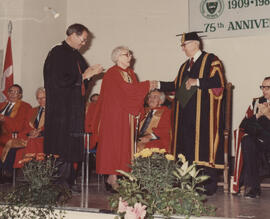
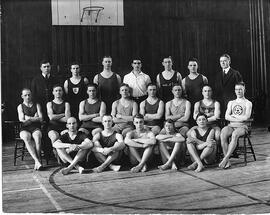
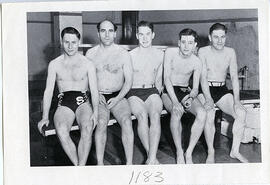
![Regina Campus - Physical Education Centre - [Architect's Sketch]](/uploads/r/university-of-saskatchewan-archives/3/8/6/386081a92524dffd045389fd526af56ab024ab0bac4186b645ae08aa7980145b/A-3569_142.jpg)
